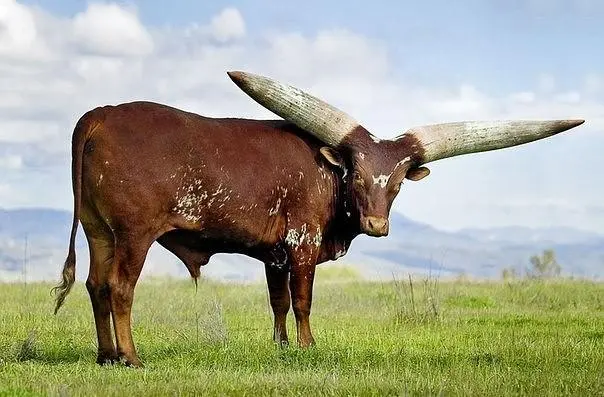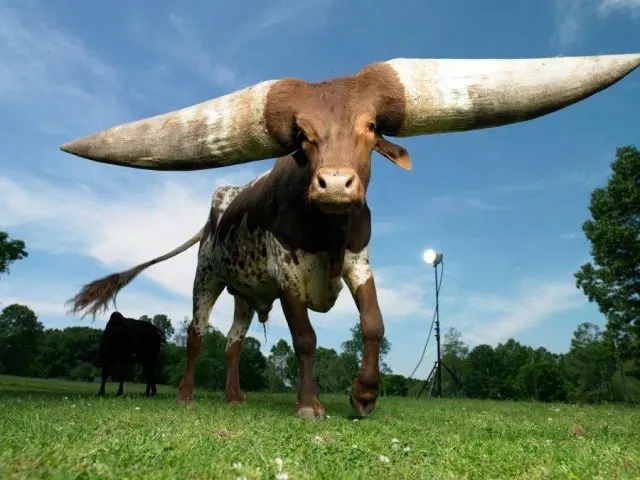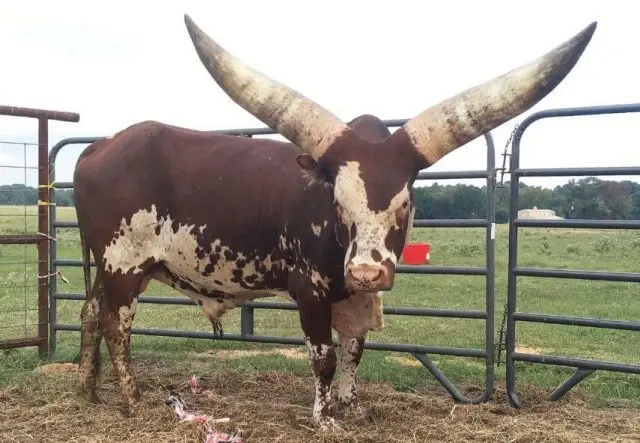Once looking at this adult animal, it is easy to guess how the Watusi bull differs from other breeds. The species has the largest horns in the world among other artiodactyls, which can reach a tip-to-tip length of 2,4 meters. In the cow kingdom, these bright representatives of the fauna are deservedly called “bulls of kings”, and in ancient times they were considered sacred. The history of the origin of the breed is interesting, as well as the importance for humans of the Wattusi bulls in antiquity and their place in the modern world.

Watusi Description
This exotic breed of cow originated from Africa, the inhabitants of Rounda and Burundi call it Watussi, and the neighboring Ugandan tribes of Nkole gave the name to the horned bulls “ankole”. The Tutsi tribe calls this breed in its own way – “inyambo”, which means “a cow with very long horns.” In many regions of Africa, representatives of this species are still considered sacred to this day.
There are two versions of the origin of the Ankole-Watusi bulls:
- according to the first version, the indigenous Africans claim that the watussi is an independent breed that arose 6 thousand years ago, the progenitor of which was an ancient relic bull (tour);
- according to the second version, the breed is 4 thousand years old, and its progenitors are primitive wild tours (Bos taurus), which came to Africa from the banks of the Nile, Indian humpback zebu bulls and Egyptian cows.
In fact, as genetic studies show, the truth lies somewhere in between. In the genes of modern Watussi bulls, traces of both wild aurochs and the Egyptian cow and Indian bull were found.
Whoever was the ancestor of the breed, the main feature of the species are huge horns: it is for them that it is valued. By the way, if the Watussi bull is deprived of its pride – horny growths, it will absolutely not differ from the rest of the representatives of the cow kingdom.
The distance between the tips of the horns of an adult, on average, is about 1,5 m. However, in a good pasture and with proper care, it can reach 2,4 – 3,7 meters. Bulls with cylindrical or lyre-shaped horns are especially valued. Males of the Watussi breed, on average, weigh 600-700 kg, females – 450-550 kg, which is slightly inferior to the ancient wild tour, whose weight reached 800 kg or even more. The growth of a cow reaches 170 cm, the length of her body is approximately 2,5 – 2,6 m. The Watusi bull usually lives 27 – 30 years.
The greater the distance between the tips of the horns and the wider they are at the base, the more valuable the animal. The lucky owner of the most beautiful “crown” is given a sacred status and the title of king of the herd. Previously, such bulls were given to a herd belonging to the king, who had only the best representatives of the breed. However, the price for this position is heavy, because the weight of one horn ranges from 45 to 50 kg, and it is not easy to wear such a “decoration”.
An interesting fact: on May 6, 2003, a bull of the Watussi Larch breed (Lurch) got into the Guinness Book of Records, who wore horns on his head with a diameter of 2,5 m and weighing 45 kg each.

The horns of the Ankole-Watussi bulls have not only a decorative function: they serve as a kind of air conditioner, with the help of which the body temperature of the animal is regulated. This is due to the blood vessels that permeate the horny growths that are hollow inside: the blood circulating in them is cooled by the air flow and diverges further throughout the body, preventing the animal from overheating. This is very true for bulls, since the African climate is very hot: the air temperature in the shade often reaches +50 degrees Celsius. That is why animals with the largest horns are considered the most valuable. After all, they are better adapted to the climate than others, which means they are more tenacious and have a higher chance of producing good offspring.
Distribution
Despite the fact that Africa is the historical homeland of Watusi bulls, this breed quickly became widespread throughout the world, due to its unpretentiousness in food and maintenance, as well as good adaptability to climatic conditions.
After 1960, Ankole Watusi began to be bred in America, where the breed quickly spread throughout the continent. The population of American Watusi bulls is approximately 1500 heads.
On the territory of the post-Soviet space, Watussi cows can be found in the Crimea and in the Askania-Nova reserve. In addition, many zoos in the world want to get this handsome bull, which is not so easy. Africa remains the main habitat of the rare breed.
Life
In the wild, the Watussi bull lives and grazes in open areas of steppes, fields and savannahs. The climate in Africa is hot, which does not contribute to the excessive mobility of animals due to the risk of overheating. Therefore, even the bulls of this breed are distinguished by a calm disposition and show aggression only during the mating season, in the form of fights and attempts to defend their right to reproduce. Otherwise, both wild and, especially, domesticated animals are slow and calm.
Since vegetation is rather sparse in the expanses of hot Africa, Watussi cows had to adapt to local nutritional conditions. They are able to digest and extract all the nutrients from literally any vegetation that they find. An adult bull needs to eat up to 100 kg of feed, a cow a little less – up to 60 – 70 kg. Therefore, these artiodactyls do not disdain even the most meager and coarse food, squeezing everything out of it.
It was the ability to adapt to harsh climatic conditions, the ability to do without water for a long time and be content with meager food that made this breed so popular among the peoples inhabiting Africa.
Unlike their progenitor, Watussi cows have very good genetics, which contributes to the continued preservation of their original lineage. In males and females, puberty occurs at the same time, by about 6 to 9 months. Gobies are ready for mating games at any time, but in heifers this period directly depends on the sexual cycle. Often this time comes in early spring, when the rainy season comes and ends closer to mid-May. After 9 – 11 months of pregnancy, the Watussi cow gives birth to one or two calves weighing from 17 to 23 kg.
Huge horns make this breed invulnerable to almost any predator and, if necessary, able to fend for itself. Watussi cows are distinguished by a well-developed maternal instinct and are very jealous of their offspring. At night, the whole herd drives the young to the center, and adult bulls are located in a circle, protecting the calves from possible danger with their powerful weapons – horns.
Role in human life

Since the Watussi bull was considered and still is a sacred animal in many African tribes, the breed is not bred for meat. On the contrary, the wealth of the owner is calculated in the number of healthy livestock.
Since ancient times, these cows have been used as a source of milk, and in view of the fact that the breed does not have a special milk yield (only about 1,5 thousand liters per individual per year), a special milking technology was invented that increases the productivity of cows.
During the day, the cow is isolated from the herd: she grazes separately. And only in the evening and in the morning is she allowed to the calf, which is allowed to drink only a few sips. This stimulates greater milk production, but the young are suffering and, in fact, sitting on a starvation diet. Therefore, it is not surprising that only a small percentage of calves, the strongest and strongest, survive, while the rest simply die from malnutrition and disease. Such a barbaric way of African tribes to increase milk production caused the population of the Watussi breed to gradually but inexorably decrease.
In addition, Africans use cows of this breed for bloodletting, drinking blood mixed with milk daily as a tonic and energizing nutritious protein drink. In some tribes, it is believed that the blood of the sacred cow Watussi is endowed with some mystical properties that give the person who drinks it supernatural strength and endurance. Thus, one adult animal must unwittingly share with its owner about four liters of blood per month.
These cows, giving their milk and blood, have become a real salvation for African natives, an opportunity to maintain human vitality and not let them die in especially difficult times.
If you look at the breeding of Watusi bulls from the point of view of European or animal husbandry, then the breed does not represent a special industrial value. It is, rather, an exotic type of cows that cannot boast of special milk yields.
Conclusion
The African bull Watussi, which has incredibly beautiful and majestic horns, is unfortunately gradually losing its population. And, first of all, this is due to the savage way of increasing the amount of milk yield, which is accepted among African natives. However, reserves in America and Europe are trying to maintain the number of this species of bulls so that the majestic animals do not disappear forever from the face of our planet.https://www.youtube.com/watch?v=avkyjWe37rc









